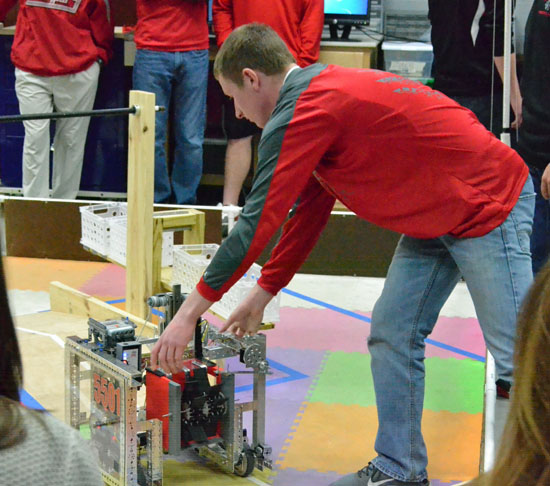VWHS Robotics Club sets lofty goals
DAVE MOSIER/independent editor
The Van Wert High School Robotics Club’s version of the USS Enterprise may not look like the spaceship made famous by the “Star Trek” television and movie series, but the club’s robotic version is taking a group of VWHS students where they haven’t gone before. And they’re wanting more.

The Robotics Club was created to give students the opportunity to participate in STEM (Science, Technology, Engineering and Math)-based educational projects. Students work in teams to build and program a robot to do a number of tasks that it will then perform in regional and state-level competitions throughout the school year. The club’s activities also fit in perfectly with VWHS’s project-based education model.
The club is open to students who are involved in the school’s Project Lead the Way engineering program, which currently has approximately 75 students enrolled in grades 9-12. In addition to the high school club, a middle school robotics club is also being organized to act as a “feeder” program for the high school and provide students earlier exposure to STEM- and project-based educational activities.
The VWHS Robotics Club members built their robot using a kit, but then designed and programmed added hardware and computer functionality to the base unit.
While only in its third year at VWHS, local students’ robot design was good enough to win first place for “Best Designed Robot” at a USFirst Robotics competition held recently in northern Indiana. The robot won seventh place overall at the contest, but the club’s goal now is to win an overall statewide competition and qualify for the world competition being held in Missouri that will include robotics teams from all over the globe.
While that’s a goal club founder and advisor Bob Spath feels is realistic, given a robot built by the club last year nearly defeated a team that later went on to win the world championship, the local club uses the competitions to learn more about what is needed to compete successfully, and to make enhancements and adjustments to its robot for future contests.
The competitions involve a number of relatively simple tasks, including putting cubes in baskets, raising a flag and hanging from a bar (extra credit), but things get very competitive, Spath noted, because there are several robots on a course layout at the same time trying to compete their tasks. In addition, one robot can inadvertently – or purposefully – hamper another robot from completing its tasks.
The exposure to real-world engineering problems and computer programming in a fun atmosphere has Robotics Club members fascinated to the point that they spend every extra minute in their days working on the robot.
“It’s the highlight of my day,” said junior Ryan Rice, who is in his first year as a member of the club and plans to pursue a degree in mechanical engineering after high school. Rice would be the third generation of engineers in his family, since his father and grandfather are also engineers.
Rice said he became interested in robotics when he was part of a team that built a much simpler robot last year. That fueled his desire to work on the Robotics Club’s much more complex robot.
Jacob Brown, a senior at VWHS, is in his second year with the program and plans to obtain an aerospace engineering degree in college.
The program has grown from six students the first year to 15 this year, and Brown said that number was about right, since Spath and Zane McElroy, the other adviser and someone Spath calls a “superstar” when it comes to robotics programming, divide the students into teams to complete various tasks related to building and programming the robot.
Members hold practices 3-4 days a week after school during the robotics “season,” which can stretch into April if a team qualifies for the world competition.
In addition to learning engineering principles and using their critical thinking skills, Robotics Club members also are exposed to state-of-the-art technology. The students use cutting-edge CAD software to design parts for the robot, while a basket used to hold cubes for competitions was manufactured using a futuristic 3D printer loaned to the program by Vantage Career Center.
The program’s annual budget of approximately $6,500 is funded through private and corporate donations, but Spath said more funding would be needed if the club qualifies for the world championship competition, since doing so wasn’t accounted for in this year’s budget.
In addition to qualifying for the Indiana state championships with its design award, the VWHS Robotics Club is also trying to win the Ohio state championships coming up in February. Winning either of those competitions would qualify the local robotics team for the world competition.
Although it’s a concern, Spath, McElroy and the VWHS Robotics Club members are all hoping that finding money to fund a run at the world championship is something they’ll have to be doing in the near future.
POSTED: 01/23/14 at 9:23 am. FILED UNDER: News







